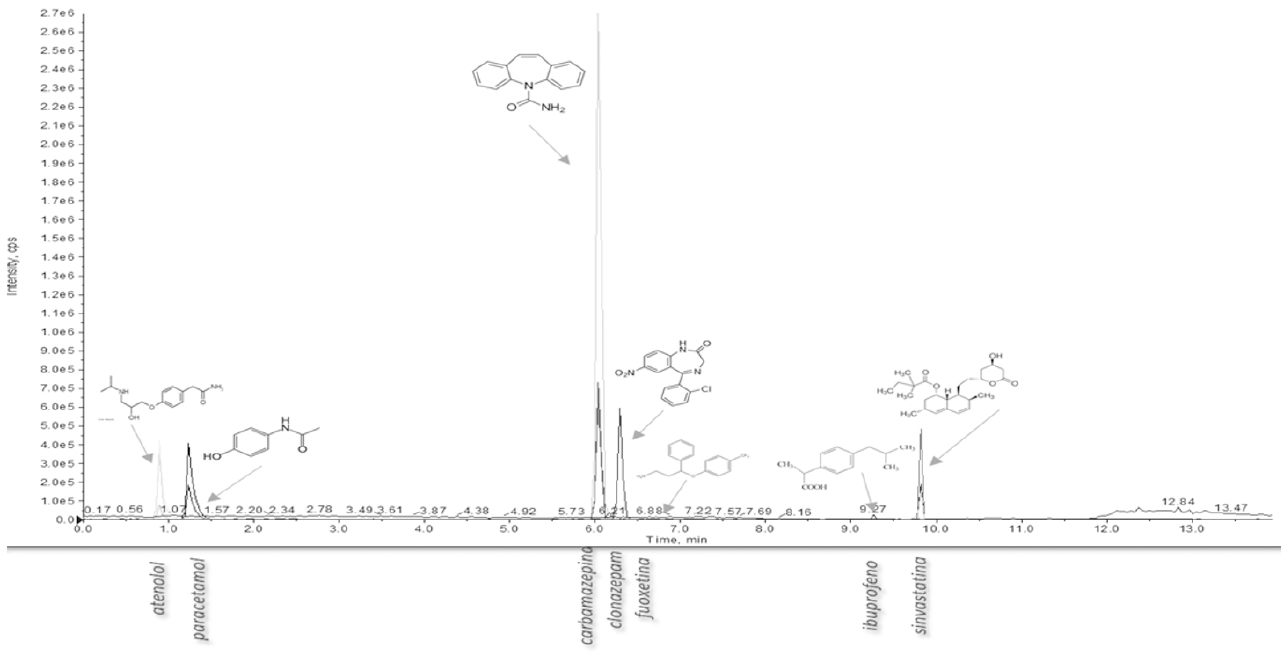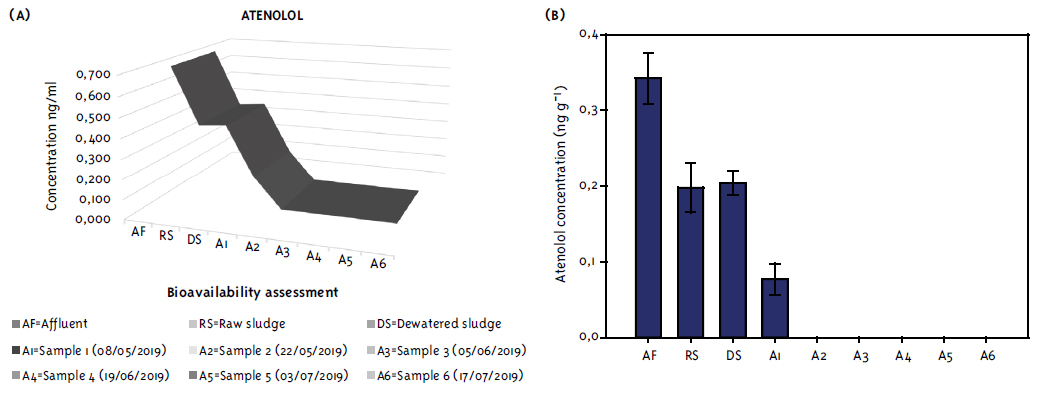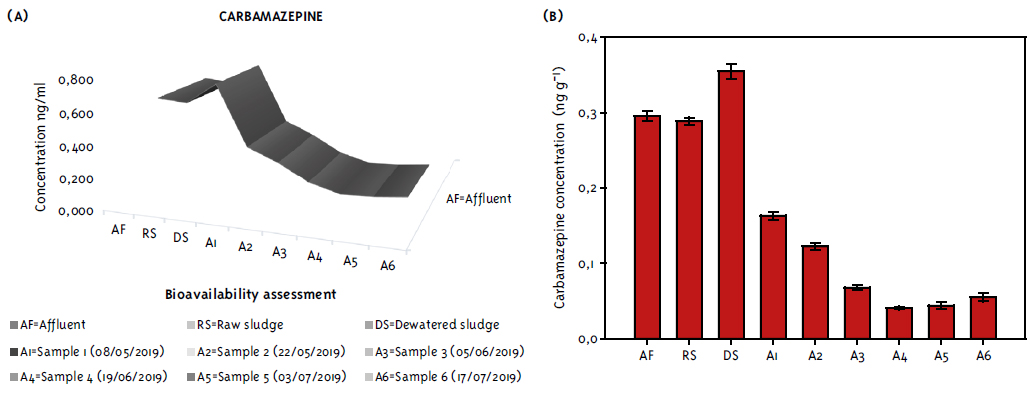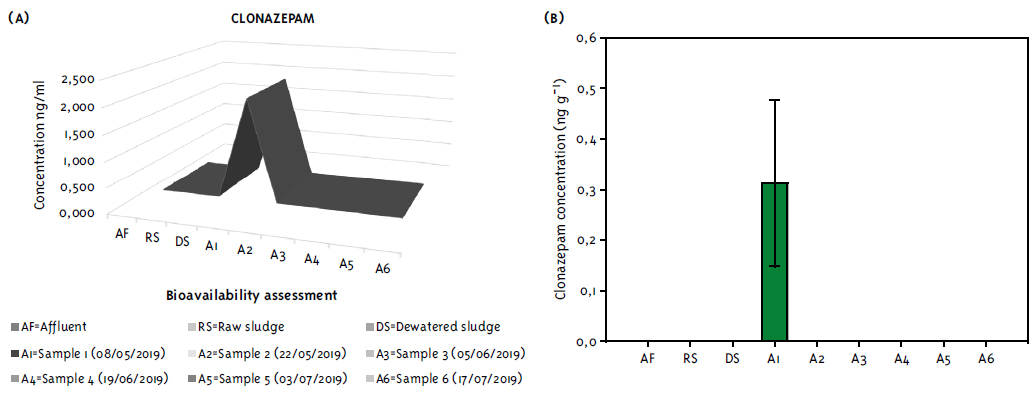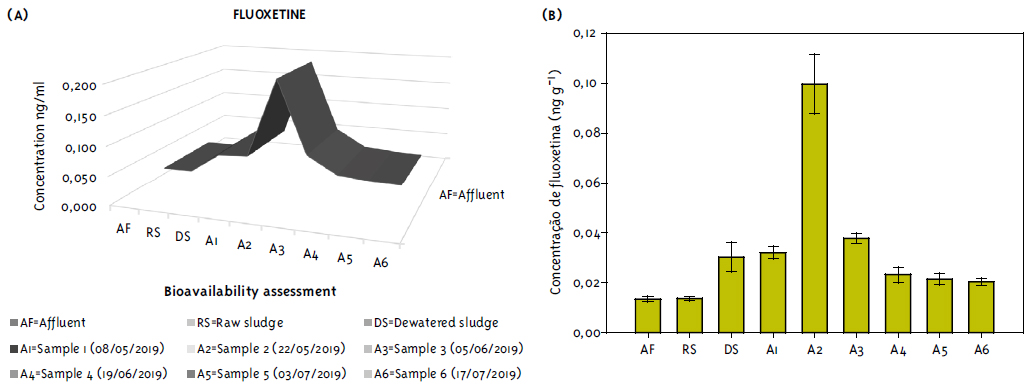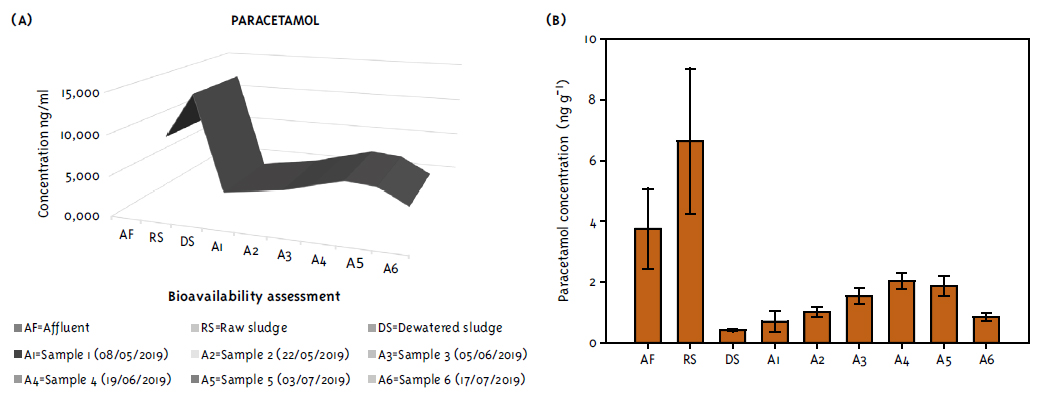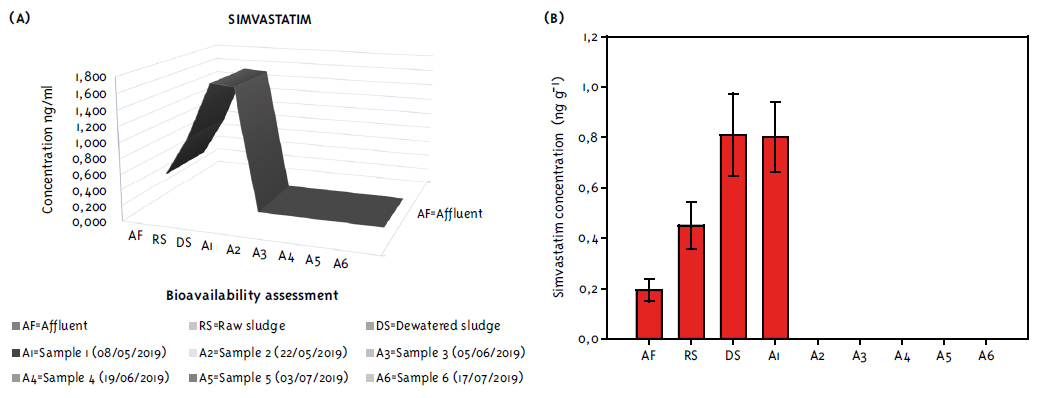Abstract
The presence of residual drugs in the environment is a growing global issue, with many studies seeking to quantify it. However, its behavior and effects, both on the environment and on humans are still mostly unknown. In this study, seven drugs were evaluated: Atenolol, Carbamazepine, Clonazepam, Ibuprofen, Paracetamol, Simvastatin, and Fluoxetine, from samples of sludge from a sewage treatment plant of the public system. The extraction of the compounds from the matrix was based on the leaching of the compounds in water and the analytical quantification was determined by an ultra-performance liquid chromatograph system, coupled to the mass spectrometer. The data indicate the possible movement of some drugs from aqueous to solid phase. We observed that the composting of the sludge could favor the biodegradation or mobilization of the compounds since there was a significant reduction in the concentrations, when comparing the values obtained before and after the composting process. The non-detection of a compound does not necessarily mean that it has been fully degraded by microorganisms; however, past studies reached similar results, which corroborates the adequacy of the methodological proposal and the adopted procedures, contributing to the production of reliable results.
Keywords:
Sewage; Composting; Pharmaceuticals; Bioremediation
Introduction
In recent decades, there has been a growing and extensive bibliographic production regarding the presence of drugs and/or their metabolites in the various environmental domains, which can be identified as the cause for numerous modifications, both at the physiological and genetic level, and with the potential to cause disorders to humans.
Many chemical products play an essential role in modern life, especially in the medical field; but they can also cause drug or pharmaceutical pollution either via excretion in the urine or improper disposal (Whitmee et al, 2015WHITMEE, S. et al. Safeguarding human health in the Anthropocene epoch: report of The Rockefeller Foundation-Lancet Commission on planetary health. The Lancet, London, v. 386, n. 10007, p. 1973-2028, 2015. DOI: 10.1016/S0140-6736(15)60901-1
https://doi.org/10.1016/S0140-6736(15)60... ). The introduction of drugs and their metabolites into the environment, especially in the water bodies, was a growing field within environmental chemistry for several years (Jones; Voulvoulis; Lester, 2001JONES O.A.H.; VOULVOULIS N.; LESTER J.N. Human pharmaceuticals in the aquatic environment a review. Environmental Technology, Berlin, v. 22, p. 1383-1394, 2001. DOI: 10.1080/09593332208618186
https://doi.org/10.1080/0959333220861818... ). Although the studies first began in the 70s, in the United States of America (USA), they only reached greater progress in the mid-90s, with the development of analytical techniques with detection limits from μg/L to ng/L, such as chromatography and mass spectrometry. Currently, the wide dissemination of drugs in the environment is evident, having been detected in wastewater, surface waters (rivers, lakes, streams, estuaries, and seas), groundwaters, as well as in soils and sediments (Harrison et al., 2006HARRISON, E. Z. et al. Organic chemicals in sewage sludges. Science of the total environment, Amsterdam, v. 367, n. 2/3, p. 481-497, 2006. DOI: 10.1016/j.scitotenv.2006.04.002
https://doi.org/10.1016/j.scitotenv.2006... ; Martin et al., 2012MARTIN, J. et al. Occurrence of pharmaceutical compounds in wastewater and sludge from wastewater treatment plants: removal and ecotoxicological impact of wastewater discharges and sludge disposal. Journal of Hazardous Materials, Amsterdam, v. 239-240, p. 40-47, 2012. DOI: 10.1016/j.jhazmat.2012.04.068
https://doi.org/10.1016/j.jhazmat.2012.0... ). The great environmental concern is not necessarily with the volume of production of a drug, but with its persistence in the environment and its biological activity, toxicity, bioaccumulation, biodegradation, among others.
In the studies conducted by Caldas et al (2013CALDAS, S. S. et al. Determination of pharmaceuticals, personal care products, and pesticides in surface and treated waters: method development and survey. Environmental Science and Pollution Research, Berlin, v. 20, n. 8, p. 5855-5863, 2013. DOI: 10.1007/s11356-013-1650-9
https://doi.org/10.1007/s11356-013-1650-... ) and Fent, Weston, and Caminada (2006FENT, K.; WESTON, A.A.; CAMINADA, D. Ecotoxicology of human. Aquatic Toxicology, Amsterdam, v. 76, p. 122-159; 2006. DOI: 10.1016/j.aquatox.2005.09.009
https://doi.org/10.1016/j.aquatox.2005.0... ), the efficiency of drug removal in sewage treatment plants was reported, demonstrating great variation depending on the pharmaceutical group evaluated.
Currently, research approaches on hormones and antibiotics have been widely increasing within the literature of emerging contaminants, with a wide production of conclusive data; however, there are still many other groups of substances that need investigation (Martin et al., 2012MARTIN, J. et al. Occurrence of pharmaceutical compounds in wastewater and sludge from wastewater treatment plants: removal and ecotoxicological impact of wastewater discharges and sludge disposal. Journal of Hazardous Materials, Amsterdam, v. 239-240, p. 40-47, 2012. DOI: 10.1016/j.jhazmat.2012.04.068
https://doi.org/10.1016/j.jhazmat.2012.0... ).
The recent advancement of methodologies and analytical techniques has allowed the detection and quantification of these compounds within environmental domains, as well as in concentrations of parts per billion (ppb) and parts per trillion (ppt), expanding the possibilities of assessing the possible effects on the biota and humans according to the presence of these substances in the environment, which has raised some concerns.
Beek et al. (2016BEEK, T. A. D. et al. Pharmaceuticals in the environment - Global occurrences and perspectives. Environmental Toxicology and Chemistry, Hoboken, v. 35, n. 4, p. 823-835, 2016. DOI : 10.1002/etc.3339.
https://doi.org/10.1002/etc.3339.... ) conducted a comprehensive literature review of 1,016 original publications and 150 review articles, consolidating the measured environmental concentration (MECs) for human and veterinary pharmaceutical substances, reported worldwide in surface water, groundwater, taps/drinking water, manure, soil, and other environmental domains into one comprehensive database. The database revealed that pharmaceutical products, or the result of their transformation, were detected in the environment of 71 countries. In total, 631 different drugs were found above the detection limit of the respective analytical methods employed, revealing distinct regional patterns. Urban wastewater appears to be the dominant emission pathway for pharmaceuticals worldwide, although emissions from industrial production, hospitals, agriculture, and aquaculture are more significant locally.
In Brazil, sewage treatment rates are still very low. The National Basic Sanitation Plan (Plano Nacional de Saneamento Básico - PLANSAB) establishes that the universalization of access to sanitation services should occur only in 2033. Likewise, Law n. 14,026, sanctioned on July 15, 2020 (Brasil, 2020BRASIL. Lei nº 14.026, de 15 de julho de 2020. Atualiza o marco legal do saneamento básico e altera a Lei nº 9.984, de 17 de julho de 2000, para atribuir à Agência Nacional de Águas e Saneamento Básico (ANA) competência para editar normas de referência sobre o serviço de saneamento, a Lei nº 10.768, de 19 de novembro de 2003, para alterar o nome e as atribuições do cargo de Especialista em Recursos Hídricos, a Lei nº 11.107, de 6 de abril de 2005, para vedar a prestação por contrato de programa dos serviços públicos de que trata o art. 175 da Constituição Federal, a Lei nº 11.445, de 5 de janeiro de 2007, para aprimorar as condições estruturais do saneamento básico no País, a Lei nº 12.305, de 2 de agosto de 2010, para tratar dos prazos para a disposição final ambientalmente adequada dos rejeitos, a Lei nº 13.089, de 12 de janeiro de 2015 (Estatuto da Metrópole), para estender seu âmbito de aplicação às microrregiões, e a Lei nº 13.529, de 4 de dezembro de 2017, para autorizar a União a participar de fundo com a finalidade exclusiva de financiar serviços técnicos especializados. Brasília, DF: Presidência da República, 2020.), which updates the legal framework of basic sanitation, established universalization goals that guarantee care by December 31, 2033. Thus, a significant increase in the number of sewage treatment plants in the country is expected, as well as an increase in the production of sludge.
There are several routes by which drugs can reach environmental domains, the most common being via its use in medicine and its consequent excretion, as well as via the improper disposal of expired drugs or of leftovers from treatments, emphasizing that information on the correct and safe way to dispose of these are rare, resulting in them reaching the sewage treatment systems or some other inappropriate disposal site.
Exposure routes of drug to environmental domains
The low volatility of pharmaceuticals indicates that distribution in the environment will occur mainly via aqueous transport. During the sewage treatment processes, drugs may go from the liquid phase to the solid phase by adsorption to suspended solids, constituting, in part, the solid waste generated in the Wastewater Treatment Plants (WWTP), in the form of sludge or surplus biomass. Figure 1 shows the routes of drug exposure in environmental domains and the ranges of concentrations observed in domestic and non-domestic sources.
In general, only a few studies correlate operational and physicochemical parameters of Wastewater Treatment Plants (WWTP) with the removal of drugs. Considering that the different treatment processes and the origin of the tributaries determine different characteristics of the sludge, it is of fundamental importance that these parameters are known and evaluated. A small number of studies contemplate the determination of drugs and personal hygiene products present in the sludge from WWTP, as well as their mobilization considering physicochemical parameters of the compounds and of the domain.
Among the studies developed, a broad approach to the subject was presented by Hester and Harrison (2013HESTER, R. E.; HARRISON, R. M. (Ed.). Pharmaceuticals in the Environmet. Issues in environmental science and technology. Cambridge: Royal Society of Chemistry, 2013. v. 41).
The movement of contaminants in water, soil, and air, as well as at the interface between different compartments, is determined by processes related to the chemical properties of substances and environmental compartments. Thus, this study aims to evaluate the behavior of the drugs Atenolol, Carbamazepine, Clonazepam, Ibuprofen, Paracetamol, Simvastatin, and Fluoxetine, in sludge from the sewage treatment plant, before and after the bioremediation process by composting.
Caminada (2021CAMINADA, S.M.L. Avaliação da presença de fármacos em biossólido compostado proveniente de Estação de Tratamento de Esgotos. 20211. 236 f. Tese (Doutorado em Ciências) - Faculdade de Saúde Pública, Universidade de São Paulo, São Paulo, 20211.) addresses the physicochemical properties and ecotoxicity of the drugs chosen for study using the QSAR model (ECOSAR-EPA), with the aim of identifying the potential for bioaccumulation and ecotoxicity of these substances.
Effects on aquatic organisms
According to Kolpin et al. (2002KOLPIN, D.W. et al. Pharmaceuticals, hormones, and other organic wastewater contaminants in US streams, 1999-2000: a national reconnaissance. Environmental Science Technology, Washington, DC, v. 36, v. 6, p. 1202-1211. 2002. DOI: 10.1021/es011055j
https://doi.org/10.1021/es011055j... ), the continuous discharge of drugs and personal care products into water bodies leads to the chronic exposure of aquatic organisms to these substances and their metabolites. The magnitude, frequency, and duration of exposure, however, have yet to be fully explored.
Most studies look at the ecotoxicity of a single pharmaceutical compound, but drugs are usually present in ecosystems in the form of complex mixtures, and therefore different interactions may occur.
Effects of emerging contaminants on human health
Drugs have intrinsic bioactive properties, so prolonged exposure to them and/or the products resulting from metabolic reactions, even at low concentrations, can lead to adverse effects for humans and ecosystems.
The effect of drugs on human health must be analyzed in an orderly and qualitative manner, taking into account the special concerns and needs of society within classes and products.
An example that requires special concern are sex hormones, which can act as endocrine disruptors in non-target organisms at low concentrations, in addition to antineoplastics and immunosuppressants used in chemotherapy, known to be potent mutagenic agents.
Notably, some additives used in medicines, such as paraffins, dyes, stabilizers, and surfactants are reported in the literature as extremely toxic products (EC50 <0.1 mg/L-1).
Pharmacodynamic activities, when joined to the ecotoxicology of drugs, are sciences that can present more conclusive results on the risk of drugs and their formulations causing environmental problems (Sanderson et al., 2004SANDERSON, H. et al. Ranking and prioritization of environmental risks of pharmaceuticals in surface waters. Regulatory Toxicology and Pharmacology, Amsterdam, v. 39, n. 2, p. 158-183, 2004. DOI: 10.1016/j.yrtph.2003.12.006
https://doi.org/10.1016/j.yrtph.2003.12.... ).
Chemicals, including drugs, can affect any level of biological hierarchy: cells, organisms, populations, and ecosystems. Subtle effects may include genetic selection, endocrine disruption, genotoxicity, and, subsequently, the alteration of metabolic behavior and species functions in the ecosystem (Jorgensen; Halling-Sorensen, 2000JORGENSEN, S.E.; HALLING-SORENSEN, B. Drugs in the environment. Chemosphere, Amsterdam, v. 40, n. 7, p. 691-699, 2000. DOI: 10.1016/S0045-6535(99)00438-5
https://doi.org/10.1016/S0045-6535(99)00... ).
The ability to distinguish the relationship between normal or healthy and abnormal or sick in complex systems is relative due to the lack of comparative systems and how they are affected. For example, mixtures between drugs and pesticides can obscure the elucidation of the subtle effects on the environment.
Subtle biological signals and/or cascade effect of drugs (extremely low concentrations) in the environment can be studied in microcosm experiments (Jorgensen; Halling-Sorensen, 2000JORGENSEN, S.E.; HALLING-SORENSEN, B. Drugs in the environment. Chemosphere, Amsterdam, v. 40, n. 7, p. 691-699, 2000. DOI: 10.1016/S0045-6535(99)00438-5
https://doi.org/10.1016/S0045-6535(99)00... ; Sanderson et al., 2003SANDERSON, H. et al. Probabilistic hazard assessment of environmentally ccurring pharmaceuticals acute toxicity to fish, daphnids and algae by ECOSAR screening. Toxicology Letters, Amsterdam, v. 144, n. 3, p. 383-395, 2003. DOI: 10.1016/s0378-4274(03)00257-1
https://doi.org/10.1016/s0378-4274(03)00... ; Giddings, 2002GIDDINGS, J. M. et al. (Ed.). Community-level aquatic system studies-interpretation criteria (CLASSIC). Washington, DC: Society of Environmental Toxicology and Chemistry, 2002.), however, the statistical analysis and interpretation of the results should inform on the accuracy of the test and the recovery time of the environment. Recovery, in this context, means return to an undisturbed natural state (Sanderson et al, 2003SANDERSON, H. et al. Probabilistic hazard assessment of environmentally ccurring pharmaceuticals acute toxicity to fish, daphnids and algae by ECOSAR screening. Toxicology Letters, Amsterdam, v. 144, n. 3, p. 383-395, 2003. DOI: 10.1016/s0378-4274(03)00257-1
https://doi.org/10.1016/s0378-4274(03)00... ).
Given the differences that can occur when evaluating the toxic potential of xenobiotics in aquatic organisms and animals, in relation to the effects they can cause in humans, Evidence-Based Toxicology, via the Toxicology in the 21st Century (Tox21) program, represents an advance in the toxicological area, especially in relation to environmental contamination.
The paradigm shift in current toxicology to one that is evidence-based tends to move away from classical animal testing toward the new in vitro and in silico toxicology, as well as mechanistic toxicology. This change becomes even more evident when considering that many toxicological studies, which are still conducted on animals, were designed a long time ago, such as in the 1950s or 1960s and the signs of regulatory safety have undergone a remarkably small change during this period. At the same time, technology in the life sciences has greatly, and rapidly, advanced; thus, toxicology needs to adapt to new technologies and knowledge.
The first meeting on Evidence-Based Toxicology was held in 2007 in Italy on Lake Como, where about 170 participants from different countries produced a common statement on the scientific community, to create a base of toxicological evidence. Several publications on the subject can be consulted, most of which were by Thomas Hartung and his team, who at that time were at the European Centre for the Validation of Alternative Methods (ECVAM).
Bioremediation by composting sludge from WWTP
Considering the need for environmentally appropriate final destination for the sludge generated in the sewage treatment process, its use for disposal in the soil for agricultural purposes has been configured as a viable alternative since it allows the reduction of the volumes destined to sanitary landfills and the use of the nutrients present in this material, contributing to the maintenance of the balance of the essential cycles of nature, especially nitrogen and phosphorus, whose sources are finite and non-renewable.
We chose composting as our object of study for several factors, but mostly due to the large and varied microbial population present in the sludge from WWTP, which contributes to the composting process. Moreover, the characteristic increase in temperature from the composting process directly interferes with the population of organisms that participate in the process. The population known as mesophilic, which presents growth between 15°C and 43°C, is very important in the initial phase of composting, when, in the presence of oxygen, aerobic and exothermic reactions occur. From that moment on, the heat released favors the increase of temperature and the growth of microorganisms called thermophiles, which grow in the range between 40°C and 85°C, contributing to the degradation reactions of the most complex compounds, such as drugs, emerging contaminants or contaminants of difficult degradation.
Development
Description of the study area
This study was developed at the Lageado WWTP, located in Botucatu, a municipality in the western region of the state of São Paulo. The WWTP uses the treatment process at the secondary level, operating with an average flow of 300L/s. Its treatment structure has the following steps: preliminary treatment composed of screening and grit removal, equalization basin, Upflow Anaerobic Sludge Blanket reactor (UASB), aeration basin (TA), secondary decanters, and disinfection of the final effluent. The sludge generated at the station is drained by mechanical centrifugation process, until it reaches solids content between 20% and 25%. The daily production of sludge is approximately 15 m³/day.
Composting process
Table 1 described the data regarding the design, installation, and operational aspects of the composting process. The table was developed in partnership with the School of Agronomic Sciences - FCA (São Paulo State University - UNESP) and the Water and waste management company of the State of São Paulo, SABESP.
The windrow was composed of dewatered sludge from the Lageado WWTP and tree pruning, used as a structuring agent, in a ratio of 1:1. The process used was by turning windrow s installed in a covered shed (Figure 2).
Preparation and conservation of samples of the affluent and sludge of the WWTP
Six sampling campaigns were carried out from May to July 2019, on the following dates: 08/05/2019; 22/05/2019; 05/06/2019; 19/06/2019; 03/07/2019; and 17/07/2019.
Collecting samples from the sewage affluent to the station
In collecting sample from the station’s affluent, only samples from the period of 24 h were considered, with the collection of an aliquot every 6 hours.
Collection of sludge samples
The samples of the generated sludge were carried out by means of simple collections, respecting the hydraulic detention time of the station, considering the dates of sampling of the affluent.
Sludge sampling was performed according to NBR 10.007/2004 (ABNT, 2004ABNT - Associação Brasileira de Normas Técnicas NBR:10.007: Amostragem de Resíduos sólidos. 2. ed. Rio de Janeiro, 2004.). The collected samples were properly identified and preserved, remaining frozen at -20°C until further preparation and quantitative analysis.
Data collection was performed as follows:
Sampling extract from raw sludge, collected in the affluent of the densifier;
Sampling of extract from centrifuged/dewatered sludge;
Sampling of composted material, considering the monitoring of the composting process for 75 days, with the samples being collected at the beginning of the process (time zero), 15 days, 30 days, 45 days, 60 days, and with 75 days, ensuring the stabilization of the biosolids composts.
Development of assays for identification and quantification of drugs in environmental domains
The quantitative assays to identify the drugs under study were carried out at the Center for Advanced Research in Matology (Núcleo de Pesquisas Avançadas em Matologia - NUPAM), located at UNESP, Lajeado campus, in the city of Botucatu, state of São Paulo.
Extraction methodology based on the saturation of compounds in water
Considering that the extraction procedures with acids or solvents do not portray the natural conditions to which the biosolid will be exposed - regarding its disposition in agriculture - a new extraction procedure was performed, seeking conditions normally found in the environment and considering the eventual exposure of this biosolid, based on the principle of saturation of the compounds in water developed in Macedo et al. (2020MACEDO, G.C et al. Behavior of sulfentrazone in the soil as influenced by cover crop before no-till soybean planting. Weed Science, Cambridge, v. 68, n. 6, p. 673-680, 2020. DOI: 10.1017/wsc.2020.70. 2020
https://doi.org/10.1017/wsc.2020.70. 202... ).
To carry out the extraction process of the samples referring to the dewatered sludge and from the composting system, they were initially thawed and sieved in a No. 6 mesh, opening 3.36mm, for removal of coarse material and homogenization. Approximately 4g of the solid sample was weighed and transferred to the test tube, after which 2ml MilliQ water was added, and the tube was properly closed. They were stored for 24 hours, at room temperature, away from light to obtain leaching. After storage period, the samples were centrifuged in a Hettich-Zentrifugen centrifuge, model ROTANTA 460R for 5 minutes, at 5000rpm, to obtain the extract. Subsequently, the extracts obtained were filtered with Millex® HV, Millipore brand, PVDF 0.45μm, diameter 13mm; transferred to vial, Analytical brand, volume 1.5ml, thread type 9mm, AMBAR, with stripe, 11.6*32mm; and duly identified for analytical quantification, using UPLCTM and MS-MS spectrometer.
The samples referring to the affluent and to raw sludge were extracted using 10ml of each and submitted to centrifugation for 5 minutes at 5000rpm; also, a 2ml aliquot of each sample was not submitted to the extraction process.
Experimental conditions - Chromatographic method
To perform the chromatographic step, the equipment was calibrated in positive mode, obtaining a mass spectrum - Multiple Reaction Monitoring (MRM). Initially, standard solutions for the studied drugs were prepared at a concentration of 100µg/ml (100ppm). Next, a mass spectrum MS-MS was selected to identify the ions produced by each of the compounds and determine the best ion pair, as well as the best conditions of the parameters for detection of each compound.
The drugs were analyzed and quantified first separately and then together (MIX), establishing the best chromatographic conditions for separation and quantification (Figure 3).
For the identification and quantification of the drugs, a system composed of ultra performance liquid chromatograph UPLCTM, Shimadzu, with the following units was used: INJECTOR: SIL-20AC HT; Controller: CBM 20A; Degasser: DGU 20A3R; 2 LC-20AD Pumps; Column oven: CTO-20AC. Coupled to the chromatographic system, a mass spectrometer model AB SCIEX, TRIPLE QUADTM 4500 was used. The mobile phase for drug determination was prepared by combining two phases: Phase A=1% formic acid in water and Phase B=1% formic acid in methanol, chromatographic column SynergyTM 2.5μm Hydro-RP 100 Å, LC Column 50x4.6mm, H18-253411. Table 2 shows the chromatographic conditions, in addition to the parameters and gradients used.
Analytical Standard Solutions
The analytical standards of the drugs used in this study were acquired at Sigma-Eldrich (Paracetamol, Atenolol, Simvastatin, and Ibuprofen) and the others (Carbamazepine, Clonazepam, and Fluoxetine) were obtained via donations from drug manufacturers. The standard solutions and stock of the drugs under study were prepared at concentrations of 100ppm (g/ml) in methanol, at 50:50 ratio (µMeOH:H2O). Subsequently, the intermediate standard solutions were prepared by successive dilutions, using the 50:50 (MeOH:H2O) phase, starting from the stock solution prepared at the time of the procedure. All prepared solutions were kept in the freezer at a temperature of -20°C and without light. Thus, a mixture containing all the compounds of interest was obtained, in concentrations ranging from 100µg/ml (ppm) to 25ng/ml (ppb). Figure 3 shows the chromatogram obtained by the injection of the drug mixtures to be evaluated.
Results and discussions
The analytical method developed at the NUPAM Laboratory proved to be efficient for quantifying the compounds evaluated, which were: Carbamazepine, Clonazepam, Ibuprofen, Paracetamol, Atenolol, Simvastatin, and Fluoxetine, using the experimental extraction procedure, based on the principle of leaching the compounds in water.
Table 3 presents the compilation of data regarding the linear ranges (analytical curves) of each drug under study.
From injections of patterns prepared in the matrix extract, the signal/noise ratios (y/n) were evaluated and were calculated by the equipment software, the LOQ (Limit of Quantification) and the LOD (Limit of Detection), expressed in mass. Considering that the signal/noise ratio was higher than 10 for several compounds at the lowest concentration evaluated (0.1953ng/ml=195.3pg/ml), we can consider this as the LOQ and LOD for almost all compounds, except for Ibuprofen, which was correctly expressed as LOQ<0.1953 ng/ml. Having been injected the volume of 0.02ml, the mass of the injected compound corresponds to 3.906 pg (picogram=10-12g). The presentation of LOQ and LOD values by mass is interesting since other analytical systems may use different injection volumes.
The compound Ibuprofen showed significant interference of the matrix, presenting a LOQ value corresponding to 62.5pg (picogram), which is equivalent to 3.125μg/ml.
Evaluation of the physicochemical and pharmacokinetic properties of the drugs under study
Table 4 represents a compilation of the data obtained in relation to the drugs under study, regarding the physicochemical and pharmacokinetic properties and aiming at the evaluation of the presence of these compounds in the domain under study.
As observed in Table 4, the drugs are predominantly in the form of metabolites, with only a small part available in unchanged form, which suggests the large volume of consumption of these compounds. However, even this small amount was detected, according to the data presented in Table 5, which refer to the quantitative determination and suggest the behavior of the drugs in relation to the composting process.
Most of the drugs under study were detected in the affluent of the WWTP, proving the presence of these compounds in the matrix. The significant reduction in the concentration of paracetamol, considering the affluent sample and the dry sludge, is justified by the high solubility in water, suggesting that a large part - around 90% - was eliminated in the dewatering process, the same can be observed with atenolol, although in a smaller proportion of about 60%. Considering the drugs Simvastatin, Carbamazepine, and Fluoxetine, there was an inverse behavior when compared with the others, and an increase in their concentration was observed when evaluated in relation to the affluent and dry sludge. These data are justified by the lower solubility in water and partition coefficient (log Kow), which suggest a tendency of sorption in the sludge, having been, therefore, partially eliminated in the dewatering process.
Process of reduction of the concentration of drugs in sewage sludge and composting process
Sorption to the solid phase, during the sewage treatment process, is an important route of removal of contaminants from the final effluent, since compounds with hydrophobic character, poorly soluble, tend to partition toward the solids of the sludge.
In the composting process, when the temperature reaches the range between 40°C and 85°C, the population of pathogens and other mesophilic microorganisms are destroyed.
The process favors the hydrolysis reactions of carbohydrates, proteins, and molecules of slow degradation, however, since the soil is a complex chemical and biological medium, it is expected that the sorption of contaminants by solid particles ends up affecting the kinetics of hydrolysis. Also due to the great microbiological activity, it is difficult to separate the biotic from the abiotic processes, since in most cases the chemical and biological degradations occur simultaneously. Enzymes and other compounds biochemically produced in soil may be involved in the transformation of xenobiotics (Fay; Silva; Melo, 2008FAY, E. F.; SILVA, C. M. M. de S.; MELO, I. S. de. Degradação abiótica de xenobióticos. In: MELO, I. S. de; AZEVEDO, J. L. de (ed.). Microbiologia Ambiental. 2. ed. Jaguariuna: Embrapa Meio Ambiente, 2008. p. 464-475.).
Identification and quantification of the drugs
Samples from the affluent, raw sludge, dehydrated sludge, and the samples generated during the composting process were analyzed, as mentioned. In the analytical stage, all analyses were performed in quintuplicate. Table 5 shows the mean concentration expressed in μg.L-1 and the relative standard deviation (RSD) of the analyses for each compound evaluated.
In Figures 4 to 9, the graphic representation (A) of the extract presents the results in the order of ppb (ng.ml-1) and refers to the volume contained in the vial of analysis, used to perform the test. The bar graphs with the confidence interval (B), plotted in SgimPlot - version 12.5, present the results in ng/g and refer to the values obtained considering the mass of biosolid and the sludge used to perform the analyses. Notably, Ibuprofen was not detected in any sample analyzed.
Atenolol: graphical representation (A) and bar chart (B), with confidence interval, plotted in SgimPlot
Carbamazepine: graphical representation (A) and bar chart (B), with confidence interval, plotted in SgimPlot
Clonazepam Paracetamol: graphical representation (A) and bar graph (B) with confidence interval, plotted in SgimPlot
Fluoxetine: graphical representation (A) and bar graph (B), with confidence interval, plotted in SgimPlot
Paracetamol: graphical representation (A) and bar graph (B), with confidence interval, plotted in SgimPlot
Simvastatin: graphical representation (A) and bar graph (B), with confidence interval, plotted in SgimPlot
The evaluation of the results, correlating the physicochemical and pharmacokinetic properties with the monitoring of the parameters of the composting process for the compounds evaluated, show the movement of some drugs in relation to the aqueous and solid phase, due to the characteristics presented during the process. This can be observed in the behavior of the studied drugs.
Biodegradation and Immobilization
Biodegradation is one of the most important mechanisms for the degradation of chemicals in the environment. However, it is a difficult process to evaluate, considering the variety of natural environments, making it difficult to be transposed into the laboratory.
In the case of drugs, the process is limited from a kinetic point of view, due to the low concentrations of the compounds found in raw sewage. According to Joss et al (2006) apud Aquino, Brandt, and Chernicharo (2013AQUINO, S.F.; BRANDT, E.M.F.; CHERNICHARO, C.A.L. Remoção de fármacos e desreguladores endócrinos em estações de tratamento de esgotos: revisão da literatura. Engenharia Sanitária e Ambiental, Rio de Janeiro, v. 18, n. 3, p. 187-204, 2013. DOI: 10.1590/S1413-41522013000300002
https://doi.org/10.1590/S1413-4152201300... ), most of these contaminants present a pseudo-first-order degradation kinetics, which means that the rate of biological transformation is directly proportional to the concentration of the compounds in the liquid phase, in addition to the concentration in the biomass (expressed in suspended solids - SS) in the system.
The data indicate that the composting process can favor the biodegradation of the compounds, and a significant reduction in its concentration was identified when compared with the initial data from the affluent and in the samples from the sludge, before the composting process.
Despite the results obtained, we must also consider that the reduction in the concentration of drugs may be related to their immobilization, considering the complexity of the matrix.
The non-detection of a compound, using the appropriate techniques, does not necessarily mean that it has been degraded by microorganisms, since the loss can occur by leaching, volatilization, and chemical and photochemical degradation.
Some substances are persistent in the environment by being resistant to biodegradation, which can cause bioconcentration, bioaccumulation, or biomagnification when incorporated into the food chain.
The pH influences the aqueous solubility and lipophilicity of a substance, which are useful considerations for understanding bioavailability. In some situations, the terms pH and pKa causes confusion. The term pH is used to describe the acidity of a solution, while pKa is characteristic of a specific compound and informs the ease with which it yields protons (H+), according to the Bronsted-Loury theory on the acid/base character. For convenience, the strength of the acid is indicated by the pKa value and can be classified, in a simplified way, as:
Strong - pKa<1
Moderate - pKa between 1-5
Weak - pKa between 5-15
Very weak - pKa>15
The residual concentrations observed for the analytes Carbamazepine, Fluoxetine, and Paracetamol, considering the values related to the pH of the medium (pH=6.2 at the end of the composting process) and pKa=13.9; 9,8; 9.38 (weak acids) respectively, indicate that they would be preferentially in their non-ionized form, which suggests their adsorption in the sludge. However, after the extraction process, they are dissociated to the aqueous phase, enabling them to being detected and quantified.
In a study conducted by Peysson and Vulliet (2013PEYSSON, W.; VULLIET, E. Determination of 136 pharmaceuticals and hormones in sewage sludge using quick, easy, cheap, effective, rugged, and safe extraction followed by analysis with liquid chromatography-time-of-flight-mass spectrometry. Journal Of Chromatography A, Amsterdam, v. 1290, p. 46-61, 2013. DOI: 10.1016/j.chroma.2013.03.057
https://doi.org/10.1016/j.chroma.2013.03... ), in which 136 drugs were evaluated in sewage sludge using the adapted QuEChERS methodology, detection by liquid chromatography, and mass spectrometry, containing one of the samples from composted sludge, the results obtained for this sample were similar to those found in this research, presenting residual for the same compounds - Paracetamol, Carbamazepine, and Fluoxetine - at concentrations corresponding to 464ng/g, 17ng/g, and 56ng/g, respectively. This suggests that the methodology and procedures adopted in our study for the identification and evaluation of the compounds were adequate and produced satisfactory results.
Ecotoxicological aspects for the analyzed drugs
With the development in the QSAR field, international agencies (USEPA, OECD, the European Community, and others) have provided toxicity assessing tools that, in addition to generating reliable information, assist in the development of new chemicals, providing a rational selection of candidate compounds, considering the variables (eco)toxicity, persistence, bioaccumulation, cost reduction, time, and animal experimentation.
In the U.S., Ecotoxicity Assessment drug issues are regulated by the Food and Drug Administration (FDA), who require evaluation if the environmental concentration at the point of entry is greater than 1μg/L. However, there is few data on the ecotoxicity of compounds that were introduced to the market before the guidelines came into force. Directive 93/67/EEC, of July 20, classifies substances according to their EC50 value.
In general, there is no significant evidence that the typical concentrations of emerging contaminants can cause acute effects on aquatic organisms; however, one should consider studies that indicate chronic effects in more sensitive organisms, submitted to relevant concentrations, considering the occurrence and partial degradation of these compounds.
Although they did not present acute effect under ecotoxicological aspect for the concentrations obtained, the residues for the analytes Paracetamol, Carbamazepine, and Fluoxetine are considered as likely to effect humans and, consequently, the public health when they were evaluated under the aspect of Tox21.
Final considerations
The drugs’ exposure routes to environmental domains, as well as their behavior, are still mostly unknown. The low volatility of pharmaceuticals indicates that distribution in the environment will occur primarily through aqueous transport.
The presence of these compounds in the various environmental domains and the growing practices aimed at the beneficial use of sewage sludge, mainly for agricultural purposes, denote the importance of research and good operational practices.
The composting process studied made it possible to verify the contribution of the methodology, to evaluate the reduction or elimination of the compounds, from the concentration in the equilibrium solution with the biosolid.
The extraction method used proved to be more suitable for evaluations of this nature since it considers the changes that occur naturally in the environment.
Considering the biodisposition process, after the evaluation of the compounds in the sewage treatment and composting process, the results obtained indicate the reduction in their concentration, which suggests a tendency to biodegradation and/or immobilization. The possibility of immobilization in the matrix is an important parameter, suggesting the need for further studies for this evaluation.
The efficiency of the composting process proved to be adequate as an alternative to evaluate the availability of contaminants present in sewage sludge.
Due to the pharmacokinetic characteristics of each compound and its metabolization processes, it is evident that only a small part is presented in unchanged form, with most undergoing various metabolization processes, eliminated in the form of metabolites, which were not investigated in the analytical process.
In relation to residual concentrations, one should consider some effects that may occur, such as synergism, antagonism, additive effects, and many other possible ones, in view of the complex mixture of residual compounds in the environment and their interactions, which could cause deleterious effects to biota and humans.
Another point to be considered is the possibility of bioaccumulation, since the compounds are partially degraded and have fat-soluble characteristics, favoring the processes of bioaccumulation.
Further differentiated evaluation regarding the effects of the compounds in humans is required, with new technologies and programs since the effects observed in test organisms and even in animals do not often represent the possible effects that can be observed in humans, which may be directly related to public health, considering the complexity and the numerous variables involved.
The reduction in the concentration observed during sewage treatment raises the hypothesis and the possibility that some of the compounds may be partitioned in the sludge, due to their physicochemical properties, a fact that explains the reduction in the concentration in sewage treatment.
Knowing that the presence of these compounds in the environment can cause damage or threats to the balance of ecosystems and biodiversity, our results indicate that composting can be a mitigative alternative to these potential environmental damages, denoting the importance of research in this area, as well as the adoption of good operational practices, aiming to ensure the quality and safety required in the beneficial use of sewage sludge, mainly for agricultural purposes.
Acknowledgements
School of Public Health (University of São Paulo - USP); Waste and water management company of the State of São Paulo - SABESP; School of Agriculture (Faculdade de Ciências Agronômicas - FCA/UNESP); and Center for Advanced Research in Matology (Núcleo de Pesquisas Avançadas em Matologia - NUPAM/UNESP)
References
- ABNT - Associação Brasileira de Normas Técnicas NBR:10.007: Amostragem de Resíduos sólidos. 2. ed. Rio de Janeiro, 2004.
- AQUINO, S.F.; BRANDT, E.M.F.; CHERNICHARO, C.A.L. Remoção de fármacos e desreguladores endócrinos em estações de tratamento de esgotos: revisão da literatura. Engenharia Sanitária e Ambiental, Rio de Janeiro, v. 18, n. 3, p. 187-204, 2013. DOI: 10.1590/S1413-41522013000300002
» https://doi.org/10.1590/S1413-41522013000300002 - BEEK, T. A. D. et al. Pharmaceuticals in the environment - Global occurrences and perspectives. Environmental Toxicology and Chemistry, Hoboken, v. 35, n. 4, p. 823-835, 2016. DOI : 10.1002/etc.3339.
» https://doi.org/10.1002/etc.3339. - BRASIL. Lei nº 14.026, de 15 de julho de 2020. Atualiza o marco legal do saneamento básico e altera a Lei nº 9.984, de 17 de julho de 2000, para atribuir à Agência Nacional de Águas e Saneamento Básico (ANA) competência para editar normas de referência sobre o serviço de saneamento, a Lei nº 10.768, de 19 de novembro de 2003, para alterar o nome e as atribuições do cargo de Especialista em Recursos Hídricos, a Lei nº 11.107, de 6 de abril de 2005, para vedar a prestação por contrato de programa dos serviços públicos de que trata o art. 175 da Constituição Federal, a Lei nº 11.445, de 5 de janeiro de 2007, para aprimorar as condições estruturais do saneamento básico no País, a Lei nº 12.305, de 2 de agosto de 2010, para tratar dos prazos para a disposição final ambientalmente adequada dos rejeitos, a Lei nº 13.089, de 12 de janeiro de 2015 (Estatuto da Metrópole), para estender seu âmbito de aplicação às microrregiões, e a Lei nº 13.529, de 4 de dezembro de 2017, para autorizar a União a participar de fundo com a finalidade exclusiva de financiar serviços técnicos especializados. Brasília, DF: Presidência da República, 2020.
- CALDAS, S. S. et al. Determination of pharmaceuticals, personal care products, and pesticides in surface and treated waters: method development and survey. Environmental Science and Pollution Research, Berlin, v. 20, n. 8, p. 5855-5863, 2013. DOI: 10.1007/s11356-013-1650-9
» https://doi.org/10.1007/s11356-013-1650-9 - CAMINADA, S.M.L. Avaliação da presença de fármacos em biossólido compostado proveniente de Estação de Tratamento de Esgotos. 20211. 236 f. Tese (Doutorado em Ciências) - Faculdade de Saúde Pública, Universidade de São Paulo, São Paulo, 20211.
- FAY, E. F.; SILVA, C. M. M. de S.; MELO, I. S. de. Degradação abiótica de xenobióticos. In: MELO, I. S. de; AZEVEDO, J. L. de (ed.). Microbiologia Ambiental. 2. ed. Jaguariuna: Embrapa Meio Ambiente, 2008. p. 464-475.
- FENT, K.; WESTON, A.A.; CAMINADA, D. Ecotoxicology of human. Aquatic Toxicology, Amsterdam, v. 76, p. 122-159; 2006. DOI: 10.1016/j.aquatox.2005.09.009
» https://doi.org/10.1016/j.aquatox.2005.09.009 - GIDDINGS, J. M. et al. (Ed.). Community-level aquatic system studies-interpretation criteria (CLASSIC). Washington, DC: Society of Environmental Toxicology and Chemistry, 2002.
- HARRISON, E. Z. et al. Organic chemicals in sewage sludges. Science of the total environment, Amsterdam, v. 367, n. 2/3, p. 481-497, 2006. DOI: 10.1016/j.scitotenv.2006.04.002
» https://doi.org/10.1016/j.scitotenv.2006.04.002 - HESTER, R. E.; HARRISON, R. M. (Ed.). Pharmaceuticals in the Environmet. Issues in environmental science and technology. Cambridge: Royal Society of Chemistry, 2013. v. 41
- JONES O.A.H.; VOULVOULIS N.; LESTER J.N. Human pharmaceuticals in the aquatic environment a review. Environmental Technology, Berlin, v. 22, p. 1383-1394, 2001. DOI: 10.1080/09593332208618186
» https://doi.org/10.1080/09593332208618186 - KOLPIN, D.W. et al. Pharmaceuticals, hormones, and other organic wastewater contaminants in US streams, 1999-2000: a national reconnaissance. Environmental Science Technology, Washington, DC, v. 36, v. 6, p. 1202-1211. 2002. DOI: 10.1021/es011055j
» https://doi.org/10.1021/es011055j - JORGENSEN, S.E.; HALLING-SORENSEN, B. Drugs in the environment. Chemosphere, Amsterdam, v. 40, n. 7, p. 691-699, 2000. DOI: 10.1016/S0045-6535(99)00438-5
» https://doi.org/10.1016/S0045-6535(99)00438-5 - MACEDO, G.C et al. Behavior of sulfentrazone in the soil as influenced by cover crop before no-till soybean planting. Weed Science, Cambridge, v. 68, n. 6, p. 673-680, 2020. DOI: 10.1017/wsc.2020.70. 2020
» https://doi.org/10.1017/wsc.2020.70. 2020 - MARTIN, J. et al. Occurrence of pharmaceutical compounds in wastewater and sludge from wastewater treatment plants: removal and ecotoxicological impact of wastewater discharges and sludge disposal. Journal of Hazardous Materials, Amsterdam, v. 239-240, p. 40-47, 2012. DOI: 10.1016/j.jhazmat.2012.04.068
» https://doi.org/10.1016/j.jhazmat.2012.04.068 - PEYSSON, W.; VULLIET, E. Determination of 136 pharmaceuticals and hormones in sewage sludge using quick, easy, cheap, effective, rugged, and safe extraction followed by analysis with liquid chromatography-time-of-flight-mass spectrometry. Journal Of Chromatography A, Amsterdam, v. 1290, p. 46-61, 2013. DOI: 10.1016/j.chroma.2013.03.057
» https://doi.org/10.1016/j.chroma.2013.03.057 - SANDERSON, H. et al. Probabilistic hazard assessment of environmentally ccurring pharmaceuticals acute toxicity to fish, daphnids and algae by ECOSAR screening. Toxicology Letters, Amsterdam, v. 144, n. 3, p. 383-395, 2003. DOI: 10.1016/s0378-4274(03)00257-1
» https://doi.org/10.1016/s0378-4274(03)00257-1 - SANDERSON, H. et al. Ranking and prioritization of environmental risks of pharmaceuticals in surface waters. Regulatory Toxicology and Pharmacology, Amsterdam, v. 39, n. 2, p. 158-183, 2004. DOI: 10.1016/j.yrtph.2003.12.006
» https://doi.org/10.1016/j.yrtph.2003.12.006 - WHITMEE, S. et al. Safeguarding human health in the Anthropocene epoch: report of The Rockefeller Foundation-Lancet Commission on planetary health. The Lancet, London, v. 386, n. 10007, p. 1973-2028, 2015. DOI: 10.1016/S0140-6736(15)60901-1
» https://doi.org/10.1016/S0140-6736(15)60901-1
Publication Dates
- Publication in this collection
07 Aug 2023 - Date of issue
2023
History
- Received
29 Nov 2022 - Reviewed
29 Nov 2022 - Accepted
22 Dec 2022



 Caption: (A) dry sludge; (B) dewatered sludge and structuring agent; (C) building the windrow; (D) Turning; (E) Windrow.
Caption: (A) dry sludge; (B) dewatered sludge and structuring agent; (C) building the windrow; (D) Turning; (E) Windrow.